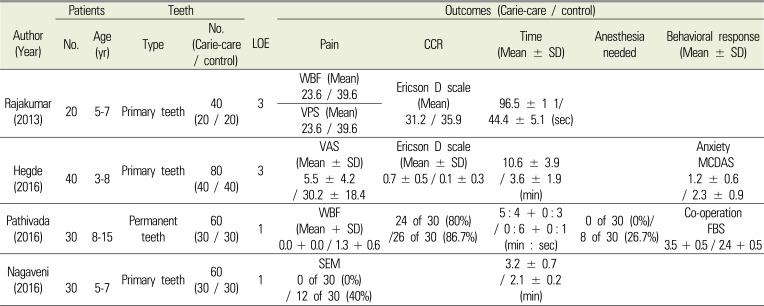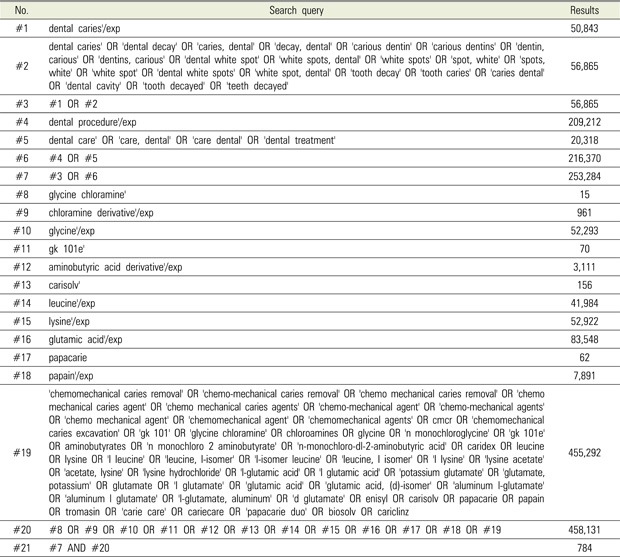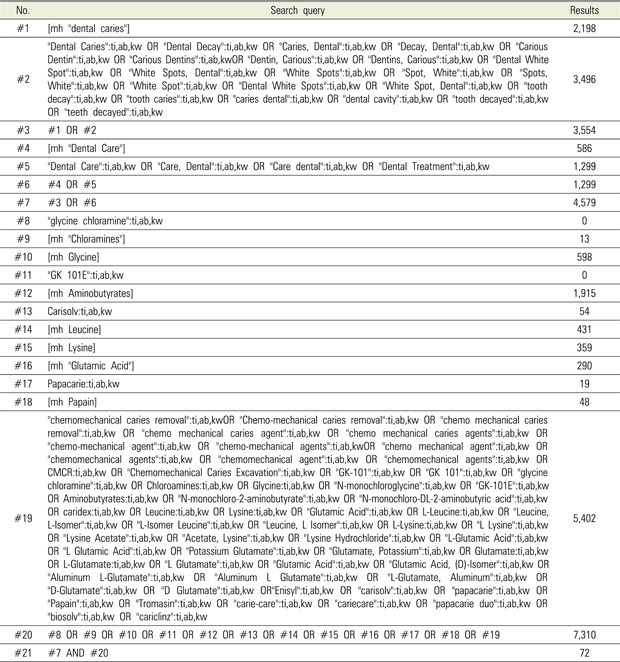Abstract
Chemo-mechanical caries removal methods are known to be more effective compared with conventional methods in pain reduction. Carie-care™, a chemo-mechanical caries removal agent, was introduced in 2010 but a systematic review of its efficacy has not yet been performed. The purpose of this study was to investigate the effectiveness of Carie-care™ on the outcomes of treatment of caries in children and adolescents. The primary outcome was pain while the secondary outcomes included complete caries removal (CCR), time, need for local anesthesia and behavioral response changes.
A Comprehensive literature search was performed in PubMed, EMBASE, and the Cochrane Library up to 30 September 2018. The following keywords were used in the search: ‘chemo-mechanical caries removal agent’, ‘dental caries’, ‘Carie-care’, ‘chemo-mechanical caries removal’, ‘chemo-mechanical caries excavation’, other related keywords, and their combinations. From 942 studies identified, 16 were analyzed. Finally, 4 studies met the eligibility criteria and 260 teeth in 120 children and adolescents were included in this review.
This review showed that Carie-care™ reduces pain during caries treatment but requires a longer time for effective treatment than conventional methods. Local anesthesia was not required in the Chemo-mechanical caries removal (CMCR) group. In addition, dental anxiety decreased compared to the control group, and co-operation was more positive. Therefore, it may be a useful alternative to conventional methods in children and adolescents, but further verification through additional studies is needed.
Pain during dental caries treatment is a major problem in dentistry [1]. Traditional caries removal methods using a rotating device cause heat, pressure, and vibration to the dental pulp, eliciting discomfort and pain to the patient and requiring local anesthesia. Moore et al. [2] reported severe dental phobia in about 10% of the adult population, especially for drilling. A related study among Korean children and adolescents found the main causes of phobia to be pain, local anesthesia, and noise from rotating instruments during dental treatment. Such phobia was responsible for the avoidance of dental visits [3]. In addition, the drilling method has a disadvantage in the large amount of tooth removal due to elimination of the sound dentin [45].
Therefore, alternative methods of conventional caries therapy were introduced for the purpose of minimal invasion without causing pain. These include sonoabrasion, air abrasion, ultrasonics, chemo-mechanical systems, and lasers [6]. Among these, the Chemomechanical system is reported to be the most effective alternative to the conventional dental removal method [789].
Chemo-mechanical caries removal (CMCR) is a method of softening carious dentin by using a chemical agent that selectively removes infected dentin while allowing for remineralization. Unlike the traditional rotary method, CMCR does not cause heat, pressure, and vibration. Consequently, there is no pain and local anesthesia is not required. Therefore, it is effective for children and adolescents, especially those with dental phobia [1011]. Some CMCR agents that are currently commercialized include Carisolv™ (Medi Team Dental AB, Savedalen, Sweden), Papacarie® (Formula e Acao, Sao Paulo, Sao Paulo, Brazil), and Carie-care™ (Uni Biotech, Pharmaceuticals Pvt., India) [1213].
In the meantime, systematic reviews and meta-analyses of the efficacy of Carisolv™ and Papacarie® have been done [71213141516]. However, these have not been done on the efficacy of Carie-care™. It is therefore, necessary to conduct these reviews and meta-analyses in order to assess the efficacy of Carie-care™ for caries removal in children and adolescents. The aim of this study was to investigate if the application of Carie-care™ can affect the outcomes of dental caries in children and adolescents. The primary outcome is pain, while the secondary outcomes include complete caries removal (CCR), time, local anesthetic need, and behavioral response changes.
This study was performed with reference to the PRISMA guidelines for systematic reviews. PICO was used to formulate the research question as follows: “Is Carie-care™, a CMCR agent, effective in reducing pain when compared to conventional drilling methods for dental caries in children and adolescents?”
A Comprehensive literature search was performed in PubMed, EMBASE, and the Cochrane Library up to 30 September 2018. The following keywords were used in the literature search: ‘chemo-mechanical caries removal agent’, ‘dental caries’, ‘Carie-care’, ‘chemo-mechanical caries removal’, ‘chemo-mechanical caries excavation’, other related keywords, and their combinations. The search was limited to publications in English. Duplicate articles were excluded from the search process along with articles not meeting the purpose of this study, using title and abstract screening. We also conducted a handwriting search on Google scholar. Afterwards, two reviewers examined the full text according to the inclusion and exclusion criteria of this study and evaluated and selected the appropriate papers.
The CMCR method is appropriate for younger patients, especially those with dental phobia, because it preserves maximal tooth structure, is less irritating to the dental pulp and reduces patient discomfort [1718]. Carisolv™ was first introduced in 1998 as a gel-type CMCR agent with sodium hypochlorite as the active ingredient and containing 3 amino acids [19]. It had some disadvantages which included that it had to be applied with specially designed instruments, was expensive, and children disliked the taste and smell of chlorine [20]. In 2003, Papacarie® was introduced and its active ingredient is papain enzyme and chloramine. Papain is antibacterial and anti-inflammatory, and chloramine is effective in removing denatured tissue. There is no need for a special device, and it is cheaper than Carisolv™. It also has the advantage of being biocompatible because it is composed of a natural material [421]. Carie-care™ is an enzyme-based gel formulation developed in 2010 and the active ingredient, endoprotein, acts as an antibacterial agent and a disinfectant. In addition, in Carie-care™, papain gel (natural anti-inflammatory property) and clove oil (analgesic and anesthetic action) compounds have additional advantages over Carisolv™ or Papacarie® [19]. In addition, Carie-care™ is less expensive than Papacarie® and has a longer shelf life [2223].
There have been attempts to conduct systematic reviews and meta-analyses on the clinical efficacy of Carisolv™ and Papacarie®. Both materials showed no significant differences in terms of CCR ability compared with traditional caries removal methods. In terms of duration, the CMCR method required more time than the conventional method. Carisolv™ was reported to require more time than Papacarie® [13]. In the CMCR method, pain was reduced compared to the conventional method, and the need for local anesthesia was reduced. Maru et al. [7] compared pain experienced by patients with visual analog scale (VAS) and found that the rotary group experienced more pain compared to the Carisolv™ group. In Deng et al.'s study [15], the pain perception assessment was performed with Wong-Baker faces pain scale (WBF), and it was found that patients treated with the traditional drill method felt significantly more pain during treatment than with Papacarie®. In addition, it was reported that patients using Papacarie® experienced less anxiety than the traditional method group. Li et al. [14] reported a significant difference in the need for local anesthesia between the Carisolv™ and conventional groups. Patients treated with Carisolv™ neither felt any discomfort nor required local anesthesia.
The results of this study showed that pain was reduced in all 4 studies [19222425] compared with the traditional method. In Rajakumar et al.'s study [19], pain was assessed by WBF and verbal pain scale (VPS). On comparing the two assessment methods, the Carie-care™ group showed lower pain scores than the conventional rotary group. In Hegde and Chaudhari's study [24], the pain threshold was evaluated during the caries removal by VAS. In comparison with the Carie-care™ group, the traditional group felt the greatest pain. In Pathivada et al.'s study [25], the degree of pain was measured by WBF: while the traditional method group felt pain, the Carie-care™ group did not feel any pain at all. Similarly, in Nagaveni et al.'s [22] study, the pain response between the two groups was assessed by the Sound, eye, and motor (SEM) scale, and the Carie-care™ group did not feel any pain compared to the traditional pain group.
In this review, CCR was reported in 3 studies [192425], with no significant difference from the traditional method except for one study [24]. In terms of time, 4 studies [19222425] showed that CMCR method took more time. One study [25] reported that more than a quarter of the traditional group subjects required local anesthesia, whereas the Carie-care™ group did not require any anesthesia.
In this study, assessment of behavioral responses was reported in 2 studies [2425]. In the Carie-care™ group, dental phobia was significantly lower than the control group [24]. In Pathivada et al.'s study [25], co-operation was measured by Frankl behavior rating scale (FBS). A more positive co-operation was also observed in the Carie-care™ group. In this study [25], Carisolv™ was also compared with traditional methods and Carie-care™ in terms of co-operation. Both CMCR groups showed significantly positive co-operation compared to the traditional group, but there was no significant difference between Carisolv™ and Carie-care™.
The studies included in this review were not suitable for meta-analysis for the following reasons: different outcome measurement scales, study design and dentition. However, this study is significant because it is the first review article to evaluate the clinical efficacy of Carie-care™ over the conventional method, with a relatively small heterogeneity in the age range of 3–15 years.
However, there were some limitations in this review. Firstly, all of the included studies were conducted in India and therefore limited general application of outcomes. Therefore, future reviews should include studies from several countries. Secondly, two of the papers were randomized controlled trials (RCTs), while the other two were LOE 3 as clinical control studies. Thirdly, the sample size was small due to the number of papers reviewed. Therefore, additional large-scale, high-quality and well-designed RCTs are required.
In conclusion, this systematic review showed that Carie-care™ as a CMCR agent reduces pain but requires more time than the conventional method during caries treatment. There was no significant difference in CCR between the two methods. Local anesthesia was not required in the CMCR group. In addition, dental phobia decreased compared to the control group, and cooperation was better. Therefore, it is a useful alternative to the conventional methods in children and adolescents, but additional studies are needed for further verification.
References
1. Geetha Priya PR, Asokan S, John JB, Punithavathy R, Karthick K. Comparison of behavioral response to caries removal methods: a randomised controlled cross over trial. J Indian Soc Pedod Prev Dent. 2014; 32:48–52. PMID: 24531602.

2. Moore R, Birn H, Kirkegaard E, Brødsgaard I, Scheutz F. Prevalence and characteristics of dental anxiety in Danish adults. Community Dent Oral Epidemiol. 1993; 21:292–296. PMID: 8222604.

3. Kim AH, Ahn ES, An SY. Factors affecting dental fear in Korean adolescents. J Korean Dent Sci. 2017; 10:22–28.
4. Bussadori SK, Castro LC, Galvão AC. Papain gel: a new chemo-mechanical caries removal agent. J Clin Pediatr Dent. 2005; 30:115–119. PMID: 16491964.

6. Banerjee A, Watson TF, Kidd EA. Dentine caries excavation: a review of current clinical techniques. Br Dent J. 2000; 188:476–482. PMID: 10859846.

7. Maru VP, Shakuntala BS, Nagarathna C. Caries removal by chemomechanical (Carisolv™) vs. rotary drill: a systematic review. Open Dent J. 2015; 31:462–472.

8. Chowdhry S, Saha S, Samadi F, Jaiswal JN, Garg A, Chowdhry P. Recent vs conventional methods of caries removal: a comparative in vivo study in pediatric patients. Int J Clin Pediatr Dent. 2015; 8:6–11. PMID: 26124574.

9. Pandit IK, Srivastava N, Gugnani N, Gupta M, Verma L. Various methods of caries removal in children: a comparative clinical study. J Indian Soc Pedod Prev Dent. 2007; 25:93–96. PMID: 17660645.

10. Motta LJ, Bussadori SK, Campanelli AP, da Silva AL, Alfaya TA, de Godoy CH, et al. Pain during removal of carious lesions in children: a randomized controlled clinical trial. Int J Dent. 2013; 2013:896381. PMID: 24363672.

11. Nadanovsky P, Cohen Carneiro F, Souza de Mello F. Removal of caries using only hand instruments: a comparison of mechanical and chemo-mechanical methods. Caries Res. 2001; 35:384–389. PMID: 11641575.

12. Lai G, Lara Capi C, Cocco F, Cagetti MG, Lingström P, Almhöjd U, et al. Comparison of Carisolv system vs traditional rotating instruments for caries removal in the primary dentition: a systematic review and meta-analysis. Acta Odontol Scand. 2015; 73:569–580. PMID: 25772193.

13. Hamama HH, Yiu CK, Burrow MF, King NM. Systematic review and meta-analysis of randomized clinical trials on chemomechanical caries removal. Oper Dent. 2015; 40:e167–e178. PMID: 26167737.

14. Li R, Zhao Y, Ye L. How to make choice of the carious removal methods, Carisolv or traditional drilling? a meta-analysis. J Oral Rehabil. 2014; 41:432–442. PMID: 24661083.

15. Deng Y, Feng G, Hu B, Kuang Y, Song J. Effects of Papacarie on children with dental caries in primary teeth: a systematic review and meta-analysis. Int J Paediatr Dent. 2018; 28:361–372. PMID: 29682851.

16. Keenan AV, Congiusta MA. Efficacy of using Carisolv in the removal of decayed tooth structure in primary teeth. Evid Based Dent. 2016; 17:44–45. PMID: 27339236.

17. Goyal PA, Kumari R, Kannan VP, Madhu S. Efficacy and tolerance of papain gel with conventional drilling method: a clinico-microbiological study. J Clin Pediatr Dent. 2015; 39:109–112. PMID: 25823480.

18. Kavvadia K, Karagianni V, Polychronopoulou A, Papagiannouli L. Primary teeth caries removal using the Carisolv chemomechanical method: a clinical trial. Pediatr Dent. 2004; 26:23–28. PMID: 15080354.
19. Rajakumar S, Mungara J, Joseph E, Philip J, Shilpa Priya MP. Evaluation of three different caries removal techniques in children: a comparative clinical study. J Clin Pediatr Dent. 2013; 38:23–26. PMID: 24579278.

20. Maragakis GM, Hahn P, Hellwig E. Clinical evaluation of chemomechanical caries removal in primary molars and its acceptance by patients. Caries Res. 2001; 35:205–210. PMID: 11385201.

21. Martins MD, Fernandes KP, Motta LJ, Santos EM, Pavesi VC, Bussadori SK. Biocompatibility analysis of chemomechanical caries removal material Papacárie on cultured fibroblasts and subcutaneous tissue. J Dent Child (Chic). 2009; 76:123–129. PMID: 19619425.
22. Nagaveni NB, Radhika NB, Satisha TS, Ashwini KS, Neni S, Gupta S. Efficacy of new chemomechanical caries removal agent compared with conventional method in primary teeth: An in vivo study. Int J Oral Health Sci. 2016; 6:52–58.

23. Venkataraghavan K, Kush A, Lakshminarayana C, Diwakar L, Ravikumar P, Patil S, et al. Chemomechanical caries removal: a review & study of an indigenously developed agent (Carie Care™ gel) in children. J Int Oral Health. 2013; 5:84–90. PMID: 24155626.
24. Hegde RJ, Chaudhari S. Comparative evaluation of mechanical and chemo-mechanical methods of caries excavation: an in vivo study. J Int Oral Health. 2016; 8:357–361.
25. Pathivada L, Krishna MK, Kalra M, Vivekanandan G, Singh J, Navit S. Clinical evaluation of a papain-based gel for the chemo-mechanical removal of caries in children. Oral Health Dent Manag. 2016; 15:145–149.
Table 1
Description of selected studies

Table 2
Summary of the features of included studies





 PDF
PDF ePub
ePub Citation
Citation Print
Print







 XML Download
XML Download